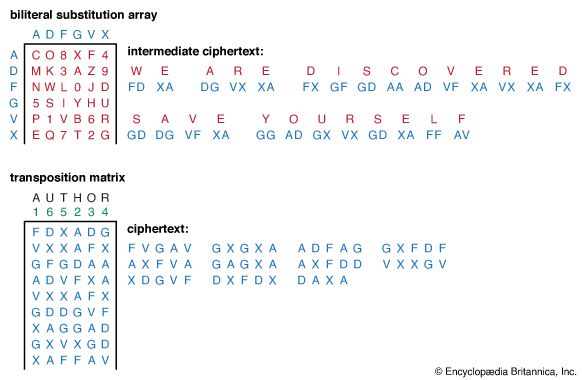cipher
Our editors will review what you’ve submitted and determine whether to revise the article.
cipher, any method of transforming a message to conceal its meaning. The term is also used synonymously with ciphertext or cryptogram in reference to the encrypted form of the message. A brief treatment of ciphers follows. For full treatment, see cryptology.
All ciphers involve either transposition or substitution, or a combination of these two mathematical operations—i.e., product ciphers. In transposition cipher systems, elements of the plaintext (e.g., a letter, word, or string of symbols) are rearranged without any change in the identity of the elements. In substitution systems, such elements are replaced by other objects or groups of objects without a change in their sequence. In systems involving product ciphers, transposition and substitution are cascaded; for example, in a system of this type called a fractionation system, a substitution is first made from symbols in the plaintext to multiple symbols in the ciphertext, which is then superencrypted by a transposition. All operations or steps involved in the transformation of a message are carried out in accordance to a rule defined by a secret key known only to the sender of the message and the intended receiver.
Cipher devices or machines have commonly been used to encipher and decipher messages. The first cipher device appears to have been employed by the ancient Greeks around 400 bce for secret communications between military commanders. This device, called the scytale, consisted of a tapered baton around which was spirally wrapped a piece of parchment inscribed with the message. When unwrapped the parchment bore an incomprehensible set of letters, but when wrapped around another baton of identical proportions, the original text reappeared. Other simple devices known as cipher disks were used by European governments for diplomatic communications by the late 1400s. These devices consisted of two rotating concentric circles, both bearing a sequence of 26 letters. One disk was used to select plaintext letters, while the other was used for the corresponding cipher component.

In 1891 Étienne Bazeries, a French cryptologist, invented a more sophisticated cipher device based on principles formulated by Thomas Jefferson of the United States nearly a century earlier. Bazeries’s so-called cylindrical cryptograph was made up of 20 numbered rotatable disks, each with a different alphabet engraved on its periphery. The disks were arranged in an agreed-upon order on a central shaft and rotated so that the first 20 letters of the message plaintext appeared in a row; the ciphertext was then formed by arbitrarily taking off any other row. The remaining letters of the message were treated in the same way, 20 letters at a time.
Advances in radio communications and electromechanical technology in the 1920s brought about a revolution in cryptodevices—the development of the rotor cipher machine. One common type of rotor system implemented product ciphers with simple monoalphabetic substitution ciphers as factors. The rotors in this machine consisted of disks with electrical contacts on each side that were hardwired to realize an arbitrary set of one-to-one connections (monoalphabetic substitution) between the contacts on opposite sides of the rotor.
The rotor cipher machine was used extensively by both the Allied and the Axis powers during World War II, with the most notable such device being the German Enigma machine. The application of electronic components in subsequent years resulted in significant increases in operation speed though no major changes in basic design. Since the early 1970s, cryptologists have adapted major developments in microcircuitry and computer technology to create new, highly sophisticated forms of cryptodevices and cryptosystems, as exemplified by the Fibonacci generator and the implementation of the Data Encryption Standard (DES) through the use of microprocessors.
















